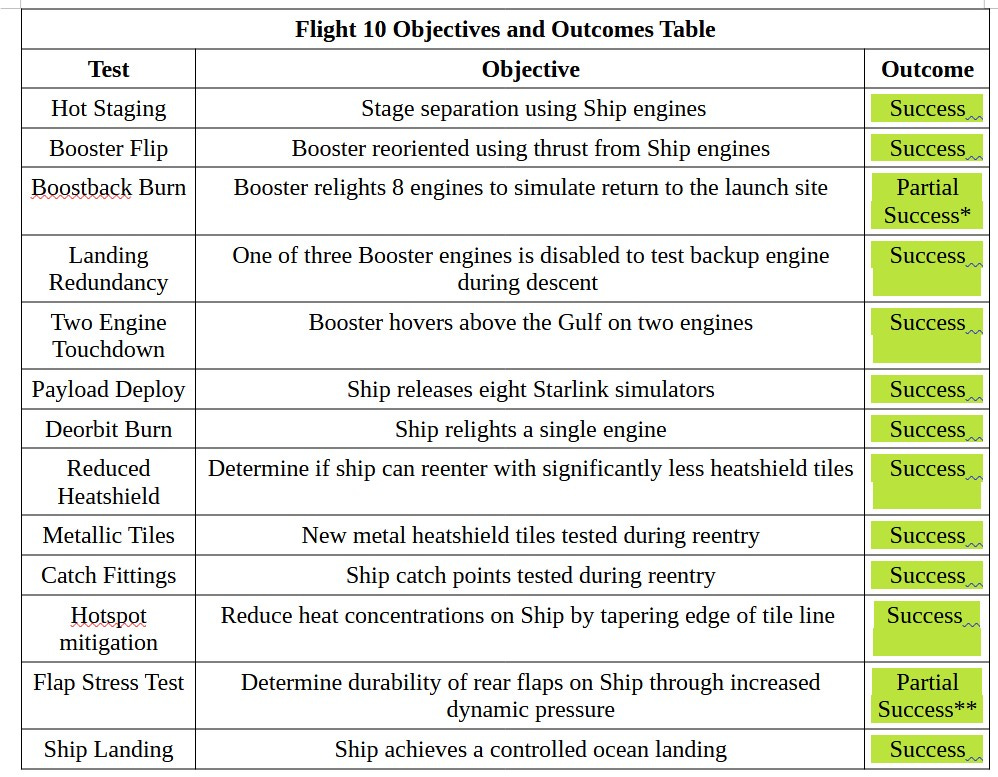Starship Power Flex
Flight 10 is a Significant Step Forward
Following a long pause to rectify issues on previous tests, Starship bounced back with a vengeance for Flight 10. SpaceX didn’t pull their punches either, as they pushed Ship 37 and Booster 16 to the limits, as shown in the table below: -
*One engine failed to relight, boostback achieved using remaining 7 engines **Some burn-through on rear flaps, no loss of control authority
“Starship made it through reentry with intentionally missing tiles, completed maneuvers to intentionally stress its flaps, had visible damage to its aft skirt and flaps, and still executed a flip and landing burn that placed it approximately 3 meters from its targeted splashdown point.” ~ SpaceX/X
Robust Performance
Following changes made from previous tests, Flight 10 demonstrated Starship’s ability to overcome adverse conditions: -
Engine Out – a booster engine shut down during ascent, booster compensated with other 32 engines.
Burn Through – extreme heat of reentry eroded trailing edges on the rear flaps, Starship still managed a controlled landing in the Indian Ocean.
Engine Bay Event – a pressure vessel ruptured near the Ship’s engines during reentry, engines functioned normally during landing.
Tile Fragments – a few fragments of heat protection tile were shed during flight, however the ship’s tough stainless steel construction allowed it to survive reentry.
Overall Starship showed a reasonable tolerance to these non-trivial issues, and proved the corrective measures from previous flights.
Big Data
SpaceX say the payload for these Starship tests is the flight data. Systems can be tested to Sunday on the ground but there’s no substitute for testing a fully integrated vehicle under flight conditions. Fortunately Flight 10 has returned comprehensive data on how the vehicle performs over a complete flight, providing invaluable information on what does and doesn’t work. Everything they learn will benefit Starship Version 3, which begins testing later this year.
“Every major objective was met [on Flight 10], providing critical data to inform designs of the next generation Starship and Super Heavy.” ~ SpaceX
Next Step
Ship 38, the last Version 2 Starship, has begun ground testing, which suggests Flight 11 should happen in 6-8 weeks. SpaceX could use this launch to deploy their Version 3 Starlink satellites, which have much higher capacity. Each Starship launch with Starlink v3 satellites will provide 60 terabits/sec bandwidth, equivalent to 20 Falcon 9 launches of Starlink v2.
Following Flight 11, SpaceX will use their Version 3 Starship to begin orbital refueling tests. In early 2026 they plan to launch a target Starship to Low Earth Orbit (LEO) followed in 3-4 weeks by a chaser Starship. If cryogenic propellant is successfully transferred between these two spacecraft, SpaceX should deploy propellant depots and dedicated propellant tankers later that year. This will open the way for Starship Human Landing System (HLS) tests on the moon and autonomous Mars landings, because these depots can be used to send ships to either destination.
“We’re going straight to Mars. The Moon is a distraction.” ~ Elon Musk/X
Elon is pushing hard for Mars which suggests the first Mars flight of Starship could occur before the first HLS test. No doubt SpaceX will shoot for Mars asap, whereas HLS will need to be approved by NASA in every detail, because it is man rated.
Big Future
“[Starship] V3 should be built & tested (maybe flown) by end of this year. [Starship] V4 is 2027. Probably closer to 150m height and 7500 tons.” ~ Elon Musk/X
Starship v3 could get us to Mars but that is only the first step towards colonization. Millions of tons of payload have to be shipped from Earth to Mars, which will require an even bigger rocket. Starship v4 will use the more powerful Version 4 Raptor engines, with 33 fitted to the booster and 9 squeezed onto the ship. SpaceX aim to field this ultimate version of Starship in 2027, ready for the 2028 Mars launch window. Capable of lifting over 200 tons of payload to Mars, it should start the ball rolling for Mars colonization.
In Conclusion
SpaceX has driven Version 2 Starships to destruction to discover points of failure. However, this hard won knowledge will improve the design of later versions, to maximize their safety for spacefaring passengers.
While SpaceX was ‘embarrassed’ by Flight 10’s success, they still managed to find some issues to address before they launch Version 3 and 4. These huge ships will become the heavy horses of space, hauling us into an extraterrestrial industrial revolution.



